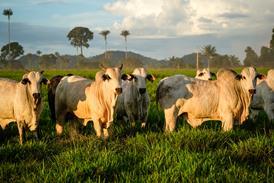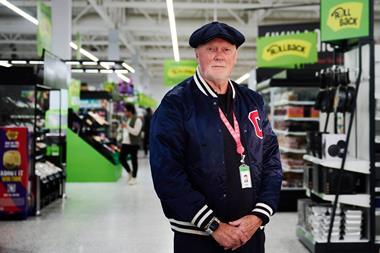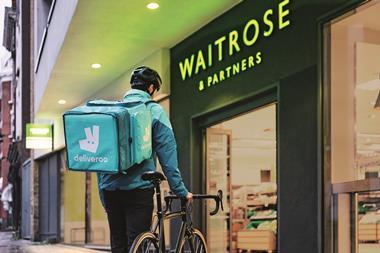The Co-operative Group's completed £1.57bn acquisition of Somerfield shows the co-op movement is once again a force to be reckoned with. But how will the deal affect the other societies? And does further consolidation lie ahead? Beth Phillips reports
The Co-op. Two very simple words used by shoppers and much of the media to describe a British institution that covers retailing, banking, funeral care, pharmacy, travel and legal services.
Yet dig deeper and you'll find a complex and fragmented co-operative movement, united by one buying group - The Co-operative Retail Trading Group - but separated by 25 consumer-owned food retail societies that remain fiercely independent.
The co-op movement has witnessed major upheaval over the past three years, however, boosted by the ambition of The Co-operative Group, the UK's largest consumer co-op. In 2006, the society reported its first quarter of like-for-like growth in two years. Since then it has recorded 12 consecutive quarters of growth thanks to a massive rebranding exercise encompassing stores, food ranges and advertising. Oh, and this week it completed its £1.57bn acquisition of Somerfield.
The deal makes The Co-op Group the fifth-largest supermarket chain . But will it work? What does the acquisition mean for the wider co-op movement? And could the deal encourage smaller societies to join forces to create one unified society?
The consensus from the City is that the acquisition will be a success, both for the society and the wider co-op movement.
The Co-op Group's chief executive Peter Marks certainly has the full backing of the banks. "We raised more than £2bn at the start of the credit crunch last summer," he explains. "Would banks lend that amount to a business if they didn't feel it was a good business proposition?"
Some are voicing concerns. Verdict Research retail analyst James Flower believes the Somerfield deal could confuse an already complex co-operative movement further. Selling The Co-operative-branded products in Somerfield branded stores may confuse shoppers, who would not necessarily realise The Co-op Group had bought Somerfield until individual stores had been converted to the fascia, he argues.
There's also a hint of disquiet about the sheer power of The Co-op Group. To satisfy local competition issues, the Office of Fair Trading ordered The Co-op Group to sell off 133 stores as a requirement for the purchase of Somerfield to go ahead. This sell-off included Somerfield stores that competed against one or more stores run by independent co-op societies, leaving societies to compete against a multiple rather than a peer.
"Smaller societies such as ours are obviously somewhat at risk from the concentration of power in the hands of The Co-op Group," says Jim Hopley, CEO of the Channel Islands Co-operative Society. "But despite his personal desire to see one co-op society, Marks has guaranteed to work with others through CRTG to the benefit of all - and I believe him."
Others view the concentration of power as a good thing. One look at the UK's larger retail co-op societies (see table, above) shows just how complex the co-op movement is. In Warwickshire and Staffordshire, for example, shoppers have the choice of four separate societies. Throw more than 20 fascias into the mix and things get all the more complex.
Such a situation creates confusion. When The Co-op Group submitted plans to build an eco-town in Leicestershire last year, campaigners staged protests outside a Midlands Co-operative Society store. And when Mosquito - a device that encourages youths to move on with a high-pitched sound only audible to the under-25s - was blasted for indiscriminately targeting young people, The Co-op Group was compelled to point out it had only been used outside former United Co-operatives stores, which merged with The Co-op Group in 2007.
The Somerfield deal has also led to misplaced sentiment. Ali Kurji, CEO of Heart of England Co-operative Society, admits he has been congratulated by a number of his customers for buying Somerfield. "The public read about 'The Co-op' taking over Somerfield, but many don't realise there are lots of smaller co-op societies," he says. "They think we are part of a national organisation. We do try and tell them we are only part of the buying group, but they don't always take it in."
There are, however, signs of unity. The Co-op Group's 'The Co-operative' fascia, launched in 2005 in an attempt to unify the movement, is starting to gather momentum. The Co-op Group rebranded 700 of its 2,000-plus stores to the fascia last year and will rebrand a further 700 this year.
In addition, Midcounties Co-operative Society, Anglia Co-operative, Chelmsford Star Co-operative Society and Radstock Co-operative Society are already rolling the fascia out across their estates. And last week they were joined by Midlands Co-operative Society and Southern Co-operatives.
"I am sure the new high-profile brand will be a catalyst for other societies to consider following suit," says Marks. "After all, 40% of groceries sold by independent societies already carry The Co-operative logo."
It's not just the brand that's catching on. A clutch of independent societies have also chosen to adopt The Co-op Group's profit-sharing dividend scheme, much-loved in the 1960s and relaunched in 2006.
So. Same buying group, same fascia, same membership scheme. Why not same society? Well, The Co-op Group's acquisition of Somerfield has already enticed Lothian Borders and Angus Co-operative Society to jump aboard.
"The long-term future of the co-operative movement is best served by greater consolidation ," CEO Bob Jamieson said when the society voted in favour of the deal last autumn.
Others are less convinced. "We have no plans to merge with The Co-op Group," says Richard Samson, CEO of the East of England Co-op. "Having a strong, national co-operative buying group means we are able to operate a regional co-operative business in the East of England that is responsive to local members' and customers' needs, while maximising our buying power ."
It's a notion Midlands Co-op CEO John Fitzgerald agrees with. "As a member of CRTG, we believe there is a real benefit in having independently owned regional societies. Being regional helps us stay close to members and customers, and we participate in CRTG for mutual benefit."
An independently owned regional bias has certainly helped Midlands Co-op strengthen its hand in the region, merging with a number of local co-ops in the past three years, most recently with Moulton Co-op last month. Somerfield aside, The Co-op Group has only embarked on two mergers over the same period.
A number of regional societies could be the way forward for the movement, says Stewart Samuel, a senior business analyst at IGD. "Because of the CRTG there is a lot of unification behind the scenes," he says, "but the smaller societies are successful in their own right and The Co-op Group can learn from them. It could be more beneficial to keep them in certain areas."
Further consolidation wouldn't be of major benefit to The Co-op Group anyway, says Verdict's Flower. "We could see further consolidation, which would make the movement simpler, but the societies are quite small. The Co-op Group has around 2,000 stores already - an extra 50 or so wouldn't make much difference to it."
Marks himself has been extremely vocal on his vision for a single society, however. And though he believes The Co-op Group now has the critical mass he so desired, he says the smaller societies can still join the CRTG as and when they see fit. And those independent societies that have signed up are clearly reaping the rewards, he adds.
Being able to piggyback on the success of a rejuvenated Co-op Group, with all its national advertising and marketing, Heart of England Co-op posted a 7.2% increase in like-for-like sales over the Christmas period, while like-for-like sales at Midcounties Co-op were up 7.6% - both ahead of the 6% recorded by The Co-op Group itself.
These independent societies have also successfully launched their own initiatives. In October, Heart of England Co-op banned the sale of knives from its food stores, to the praise of its Midlands community. East of England Co-op, meanwhile, reduced carrier bag usage by 84% after introducing a bag charge in September - something The Co-op Group has yet to do.
It's no surprise they're also relishing the thought of The Co-op Group owning Somerfield. "It's good news for the movement and for Anglia because the brand will have a higher national profile and a greater local presence," believes John Chilcott, CEO of Anglia Co-operative. "There will be a consequent growth in membership that will benefit all societies trading under The Co-operative brand."
The movement has big ambitions, says Sam Tudor, member of The Co-op Group Cambridge and East Anglia area committee. "Management has decided that we must no longer implicitly accept the slow, managed decline of the movement.
"While there is evidence of expansion elsewhere in the society, such as the merger of The Co-operative Financial Services with Britannia Building Society, the sheer amount of capital invested in the purchase of Somerfield shows the society still has considerable ambition in the food business."
Whether part of The Co-op Group or not, there is every reason to believe independent co-op societies can benefit from Somerfield's acquisition. With greater presence on the high street and bigger buying power, shoppers will notice 'The Co-op' even more in the future. It may be a complicated set up, but it is one that works - and one the majority seem happy to continue with.
A single co-op society? Not yet, but don't rule it out completely.
The Co-op. Two very simple words used by shoppers and much of the media to describe a British institution that covers retailing, banking, funeral care, pharmacy, travel and legal services.
Yet dig deeper and you'll find a complex and fragmented co-operative movement, united by one buying group - The Co-operative Retail Trading Group - but separated by 25 consumer-owned food retail societies that remain fiercely independent.
The co-op movement has witnessed major upheaval over the past three years, however, boosted by the ambition of The Co-operative Group, the UK's largest consumer co-op. In 2006, the society reported its first quarter of like-for-like growth in two years. Since then it has recorded 12 consecutive quarters of growth thanks to a massive rebranding exercise encompassing stores, food ranges and advertising. Oh, and this week it completed its £1.57bn acquisition of Somerfield.
The deal makes The Co-op Group the fifth-largest supermarket chain . But will it work? What does the acquisition mean for the wider co-op movement? And could the deal encourage smaller societies to join forces to create one unified society?
The consensus from the City is that the acquisition will be a success, both for the society and the wider co-op movement.
The Co-op Group's chief executive Peter Marks certainly has the full backing of the banks. "We raised more than £2bn at the start of the credit crunch last summer," he explains. "Would banks lend that amount to a business if they didn't feel it was a good business proposition?"
Some are voicing concerns. Verdict Research retail analyst James Flower believes the Somerfield deal could confuse an already complex co-operative movement further. Selling The Co-operative-branded products in Somerfield branded stores may confuse shoppers, who would not necessarily realise The Co-op Group had bought Somerfield until individual stores had been converted to the fascia, he argues.
There's also a hint of disquiet about the sheer power of The Co-op Group. To satisfy local competition issues, the Office of Fair Trading ordered The Co-op Group to sell off 133 stores as a requirement for the purchase of Somerfield to go ahead. This sell-off included Somerfield stores that competed against one or more stores run by independent co-op societies, leaving societies to compete against a multiple rather than a peer.
"Smaller societies such as ours are obviously somewhat at risk from the concentration of power in the hands of The Co-op Group," says Jim Hopley, CEO of the Channel Islands Co-operative Society. "But despite his personal desire to see one co-op society, Marks has guaranteed to work with others through CRTG to the benefit of all - and I believe him."
Others view the concentration of power as a good thing. One look at the UK's larger retail co-op societies (see table, above) shows just how complex the co-op movement is. In Warwickshire and Staffordshire, for example, shoppers have the choice of four separate societies. Throw more than 20 fascias into the mix and things get all the more complex.
Such a situation creates confusion. When The Co-op Group submitted plans to build an eco-town in Leicestershire last year, campaigners staged protests outside a Midlands Co-operative Society store. And when Mosquito - a device that encourages youths to move on with a high-pitched sound only audible to the under-25s - was blasted for indiscriminately targeting young people, The Co-op Group was compelled to point out it had only been used outside former United Co-operatives stores, which merged with The Co-op Group in 2007.
The Somerfield deal has also led to misplaced sentiment. Ali Kurji, CEO of Heart of England Co-operative Society, admits he has been congratulated by a number of his customers for buying Somerfield. "The public read about 'The Co-op' taking over Somerfield, but many don't realise there are lots of smaller co-op societies," he says. "They think we are part of a national organisation. We do try and tell them we are only part of the buying group, but they don't always take it in."
There are, however, signs of unity. The Co-op Group's 'The Co-operative' fascia, launched in 2005 in an attempt to unify the movement, is starting to gather momentum. The Co-op Group rebranded 700 of its 2,000-plus stores to the fascia last year and will rebrand a further 700 this year.
In addition, Midcounties Co-operative Society, Anglia Co-operative, Chelmsford Star Co-operative Society and Radstock Co-operative Society are already rolling the fascia out across their estates. And last week they were joined by Midlands Co-operative Society and Southern Co-operatives.
"I am sure the new high-profile brand will be a catalyst for other societies to consider following suit," says Marks. "After all, 40% of groceries sold by independent societies already carry The Co-operative logo."
It's not just the brand that's catching on. A clutch of independent societies have also chosen to adopt The Co-op Group's profit-sharing dividend scheme, much-loved in the 1960s and relaunched in 2006.
So. Same buying group, same fascia, same membership scheme. Why not same society? Well, The Co-op Group's acquisition of Somerfield has already enticed Lothian Borders and Angus Co-operative Society to jump aboard.
"The long-term future of the co-operative movement is best served by greater consolidation ," CEO Bob Jamieson said when the society voted in favour of the deal last autumn.
Others are less convinced. "We have no plans to merge with The Co-op Group," says Richard Samson, CEO of the East of England Co-op. "Having a strong, national co-operative buying group means we are able to operate a regional co-operative business in the East of England that is responsive to local members' and customers' needs, while maximising our buying power ."
It's a notion Midlands Co-op CEO John Fitzgerald agrees with. "As a member of CRTG, we believe there is a real benefit in having independently owned regional societies. Being regional helps us stay close to members and customers, and we participate in CRTG for mutual benefit."
An independently owned regional bias has certainly helped Midlands Co-op strengthen its hand in the region, merging with a number of local co-ops in the past three years, most recently with Moulton Co-op last month. Somerfield aside, The Co-op Group has only embarked on two mergers over the same period.
A number of regional societies could be the way forward for the movement, says Stewart Samuel, a senior business analyst at IGD. "Because of the CRTG there is a lot of unification behind the scenes," he says, "but the smaller societies are successful in their own right and The Co-op Group can learn from them. It could be more beneficial to keep them in certain areas."
Further consolidation wouldn't be of major benefit to The Co-op Group anyway, says Verdict's Flower. "We could see further consolidation, which would make the movement simpler, but the societies are quite small. The Co-op Group has around 2,000 stores already - an extra 50 or so wouldn't make much difference to it."
Marks himself has been extremely vocal on his vision for a single society, however. And though he believes The Co-op Group now has the critical mass he so desired, he says the smaller societies can still join the CRTG as and when they see fit. And those independent societies that have signed up are clearly reaping the rewards, he adds.
Being able to piggyback on the success of a rejuvenated Co-op Group, with all its national advertising and marketing, Heart of England Co-op posted a 7.2% increase in like-for-like sales over the Christmas period, while like-for-like sales at Midcounties Co-op were up 7.6% - both ahead of the 6% recorded by The Co-op Group itself.
These independent societies have also successfully launched their own initiatives. In October, Heart of England Co-op banned the sale of knives from its food stores, to the praise of its Midlands community. East of England Co-op, meanwhile, reduced carrier bag usage by 84% after introducing a bag charge in September - something The Co-op Group has yet to do.
It's no surprise they're also relishing the thought of The Co-op Group owning Somerfield. "It's good news for the movement and for Anglia because the brand will have a higher national profile and a greater local presence," believes John Chilcott, CEO of Anglia Co-operative. "There will be a consequent growth in membership that will benefit all societies trading under The Co-operative brand."
The movement has big ambitions, says Sam Tudor, member of The Co-op Group Cambridge and East Anglia area committee. "Management has decided that we must no longer implicitly accept the slow, managed decline of the movement.
"While there is evidence of expansion elsewhere in the society, such as the merger of The Co-operative Financial Services with Britannia Building Society, the sheer amount of capital invested in the purchase of Somerfield shows the society still has considerable ambition in the food business."
Whether part of The Co-op Group or not, there is every reason to believe independent co-op societies can benefit from Somerfield's acquisition. With greater presence on the high street and bigger buying power, shoppers will notice 'The Co-op' even more in the future. It may be a complicated set up, but it is one that works - and one the majority seem happy to continue with.
A single co-op society? Not yet, but don't rule it out completely.
Recent mergers
February 2009: Moulton Co-op with Midlands Co-op
October 2008: Lothian Borders and Angus Co-op with The Co-op Group
August 2007: Raunds Co-op with Midlands Co-op
July 2007: United Co-op with The Co-op Group
January 2007: Leeds and Sheffield co-ops with United Co-op
November 2006: Ilkeston Co-op with Midlands Co-op
October 2006: Ipswich & Norwich and Colchester & East Essex co-ops merge to create East of England Co-op
May 2006: Desborough Industrial Co-op with Midlands Co-op
March 2006: Brixham Co-op with Plymouth & South West Co-op
September 2005: Oxford, Swindon & Gloucester and West Midlands merge to create Midcounties Co-op
February 2009: Moulton Co-op with Midlands Co-op
October 2008: Lothian Borders and Angus Co-op with The Co-op Group
August 2007: Raunds Co-op with Midlands Co-op
July 2007: United Co-op with The Co-op Group
January 2007: Leeds and Sheffield co-ops with United Co-op
November 2006: Ilkeston Co-op with Midlands Co-op
October 2006: Ipswich & Norwich and Colchester & East Essex co-ops merge to create East of England Co-op
May 2006: Desborough Industrial Co-op with Midlands Co-op
March 2006: Brixham Co-op with Plymouth & South West Co-op
September 2005: Oxford, Swindon & Gloucester and West Midlands merge to create Midcounties Co-op
What have the societies got planned for 2009?
John Fitzgerald
CEO, Midlands Co-op
"Midlands Co-op is well placed to meet the current economic demands and we have exciting plans for the year that include the roll-out of The Co-operative brand to our estate, 50 refits and a number of store acquisitions. We are optimistic about the future."
Richard Samson
CEO, East of England Co-op
"Our development programme is likely to involve capital expenditure of £50m over the next three years and will include acquisitions, new-build stores, extensions and refurbs. We will face competition from the Somerfield sell-offs, but are up for the challenge."
Mark Smith
CEO, Southern Co-operatives
"Our priority is to complete the refitting and integration of our 20 new stores, with a continued drive to achieve additional growth through further acquisitions. We want to ensure we deliver a quality top-up shopping experience in each of our 130 stores. "
John Chillcott
CEO, Anglia Co-operative
"Anglia has recently completed a full rebranding and refurbishment, so 2009 is about offering the consumer the best possible experience in store . We need to further improve operations and drive efficiencies from increased volume and new equipment."
Ali Kurji
CEO, Heart of England Co-op
"We are planning to continue our store refurbishment programme this year. We have done four stores so far and they are trading well, all showing healthy increases in turnover. Trading to date has been good and early indications are that we are already ahead of last year."
Jim Hopley
CEO, Channel Islands Co-op
"We will continue revamping our existing stores and tidying up our in-Island local branding. We will also finish the redevelopment of our flagship Jersey store, which is our most successful large store . We will also continue to diversify outside our core food business."
John Fitzgerald
CEO, Midlands Co-op
"Midlands Co-op is well placed to meet the current economic demands and we have exciting plans for the year that include the roll-out of The Co-operative brand to our estate, 50 refits and a number of store acquisitions. We are optimistic about the future."
Richard Samson
CEO, East of England Co-op
"Our development programme is likely to involve capital expenditure of £50m over the next three years and will include acquisitions, new-build stores, extensions and refurbs. We will face competition from the Somerfield sell-offs, but are up for the challenge."
Mark Smith
CEO, Southern Co-operatives
"Our priority is to complete the refitting and integration of our 20 new stores, with a continued drive to achieve additional growth through further acquisitions. We want to ensure we deliver a quality top-up shopping experience in each of our 130 stores. "
John Chillcott
CEO, Anglia Co-operative
"Anglia has recently completed a full rebranding and refurbishment, so 2009 is about offering the consumer the best possible experience in store . We need to further improve operations and drive efficiencies from increased volume and new equipment."
Ali Kurji
CEO, Heart of England Co-op
"We are planning to continue our store refurbishment programme this year. We have done four stores so far and they are trading well, all showing healthy increases in turnover. Trading to date has been good and early indications are that we are already ahead of last year."
Jim Hopley
CEO, Channel Islands Co-op
"We will continue revamping our existing stores and tidying up our in-Island local branding. We will also finish the redevelopment of our flagship Jersey store, which is our most successful large store . We will also continue to diversify outside our core food business."
Marks and Mason on WHy the somerfield deal will work
Merging a big retail business is never a simple process – just ask Morrisons following its takeover of Safeway in 2004 – but the heads of both The Co-operative Group and Somerfield are confident this week’s £1.57bn deal will work.“It’s a new era in the transformation of the iconic co-operative brand back into the premier league,” The Co-op Group CEO Peter Marks told The Grocer. “And that’s where we intend to stay.”Paul Mason, who steps down as CEO of Somerfield but will be available in an advisory capacity, says The Co-op Group will benefit from economies of scale. “Through acquiring Somerfield, the Co-op Group is doubling its size. This will drive an improvement in the overall customer offer, especially around the value that the Co-op Group can give to customers.”The first task on Marks’ very long ‘to do’ list is to make sure the Somerfield business continues to run smoothly. “This week has been all about communication,” he says. “We’ve been telling our colleagues what the deal means for us, for customers and for the business in general.” He’s also keen to avoid confusion for Somerfield shoppers. “Somerfield customers are very happy and we don’t want to destabilise this,” he says. “Over the next few months it will be business as usual for them but when we start re-badging stores we’ll go though the whole communication process with them.” Shoppers, for example, won’t be able to use their The Co-op Group membership cards in Somerfield stores until they have been rebranded. However, The Co-operative own-label products will eventually start being stocked in Somerfield branded stores and shoppers will be able to use Somerfield gift vouchers and coupons in both Somerfield and The Co-op Group stores.Marks says he has a detailed and comprehensive integration plan which, for now, he’s keeping close to his chest. He plans to have Somerfield fully integrated within two years. Work will start immediately to rebrand Somerfield stores and the society will continue to dispose of stores that don’t fit its “strategic future profile” beyond the 133 stores it was ordered to sell by the Office of Fair Trading. Sainsbury's snapped up 24 stores this week, while Tesco, Morrisons, Waitrose, Spar and Musgrave bought stores earlier this year. Although the locations of some of the stores have not been revealed, around 25 were not on the OFT’s list.According to Mason, the retailer’s availability systems and processes are expected to play a key role in the integration process, as well as range control, and its value range Simply Value.“Ultimately, we’re aiming for one own-label range across each tier within two years,” adds Marks.
Merging a big retail business is never a simple process – just ask Morrisons following its takeover of Safeway in 2004 – but the heads of both The Co-operative Group and Somerfield are confident this week’s £1.57bn deal will work.“It’s a new era in the transformation of the iconic co-operative brand back into the premier league,” The Co-op Group CEO Peter Marks told The Grocer. “And that’s where we intend to stay.”Paul Mason, who steps down as CEO of Somerfield but will be available in an advisory capacity, says The Co-op Group will benefit from economies of scale. “Through acquiring Somerfield, the Co-op Group is doubling its size. This will drive an improvement in the overall customer offer, especially around the value that the Co-op Group can give to customers.”The first task on Marks’ very long ‘to do’ list is to make sure the Somerfield business continues to run smoothly. “This week has been all about communication,” he says. “We’ve been telling our colleagues what the deal means for us, for customers and for the business in general.” He’s also keen to avoid confusion for Somerfield shoppers. “Somerfield customers are very happy and we don’t want to destabilise this,” he says. “Over the next few months it will be business as usual for them but when we start re-badging stores we’ll go though the whole communication process with them.” Shoppers, for example, won’t be able to use their The Co-op Group membership cards in Somerfield stores until they have been rebranded. However, The Co-operative own-label products will eventually start being stocked in Somerfield branded stores and shoppers will be able to use Somerfield gift vouchers and coupons in both Somerfield and The Co-op Group stores.Marks says he has a detailed and comprehensive integration plan which, for now, he’s keeping close to his chest. He plans to have Somerfield fully integrated within two years. Work will start immediately to rebrand Somerfield stores and the society will continue to dispose of stores that don’t fit its “strategic future profile” beyond the 133 stores it was ordered to sell by the Office of Fair Trading. Sainsbury's snapped up 24 stores this week, while Tesco, Morrisons, Waitrose, Spar and Musgrave bought stores earlier this year. Although the locations of some of the stores have not been revealed, around 25 were not on the OFT’s list.According to Mason, the retailer’s availability systems and processes are expected to play a key role in the integration process, as well as range control, and its value range Simply Value.“Ultimately, we’re aiming for one own-label range across each tier within two years,” adds Marks.



















No comments yet